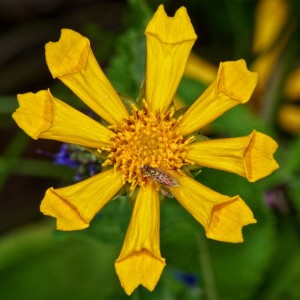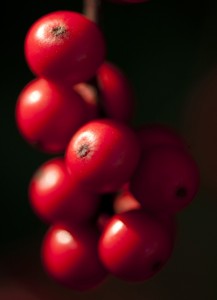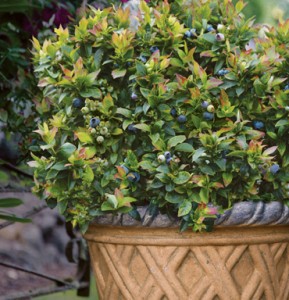Morning Eye Candy: When Blue Sees Red
Posted in Photography on December 8 2014, by Lansing Moore
Highbush blueberry adds a warm splash of red to a winter’s day.
Vaccinium corymbosum ‘Elliott’ in the Native Plant Garden – Photo by Ivo M. Vermeulen

Inside The New York Botanical Garden
Posted in Photography on December 8 2014, by Lansing Moore
Highbush blueberry adds a warm splash of red to a winter’s day.
Vaccinium corymbosum ‘Elliott’ in the Native Plant Garden – Photo by Ivo M. Vermeulen
Posted in Gardens and Collections on July 3 2013, by Thomas Andres
Thomas Andres is an Honorary Research Associate with The New York Botanical Garden.

This Fourth of July, remember to look around you for pyrotechnics in the Garden. I don’t mean to suggest there will be literal fireworks at your feet, of course. Perhaps the closest a plant comes to that is the lowly clubmoss (Lycopodium sp.), which is actually a fern ally and not a true moss. In the fall, gathered spores from clubmoss are highly flammable and have been used for generations to make flash powder. Today you may only see it used by magicians, but it was once popular in early photography as a rudimentary flash for large format cameras, not to mention its use in actual fireworks.
The pyrotechnics I am talking about are the plants that bear a resemblance to our favorite fireworks in various ways. Some even have names that suggest this, such as ‘Giant Sunburst’, firecracker flower, flaming sword, and torch lily. They have the advantage over real fireworks by making a show in the daytime with a much longer-lasting display, making them much easier to photograph. They are also considerably more diverse, and I’d say more beautiful, albeit without the bang.
Posted in Gardening Tips on May 7 2013, by Sonia Uyterhoeven
Sonia Uyterhoeven is the NYBG‘s Gardener for Public Education.

Our newest garden, the Native Plant Garden is a 3.5-acre notebook of ideas for your home garden. Native shrubs—like the ones you will see here—are an asset to any landscape, as many of them are durable plants which serve as homes and food for native bird species. Native shrubs often have beautiful spring or summer flowers and colorful fall foliage.
Deciduous winterberry hollies, Ilex verticillata, a standard in the nursery trade, are indigenous from Nova Scotia through Florida and west to Missouri. In their native habitat they prefer moist soils and swampy areas where they tend to sucker. However they will still grow prodigiously in average garden soil, but with a more upright form that can tolerate full sun and light shade.
These hollies are dioecious meaning there are male and female flowers on separate plants. The females are covered with berries later in the season. The male, meanwhile, can be tucked back in a corner. The bright-colored berries, technically drupes, are often red, but can vary from scarlet to orange-yellow, and are eaten later in the winter by over-wintering birds. They are too hard for migratory species which mean they hang on into the winter when they can nourish the birds toughing out the winter, hence the name “winterberry.”
Posted in Gardening Tips on January 8 2013, by Sonia Uyterhoeven
Sonia Uyterhoeven is the NYBG‘s Gardener for Public Education.
 Last week I introduced you to a few new dwarf blueberry and raspberry cultivars that are on the market this year: blueberry Vaccinium corymbosum ‘Jelly Bean’, blueberry Vaccinium corymbosum ‘Peach Sorbet’, and raspberry Rubus idaeus ‘Raspberry Shortcake’. This week I would like to tell you more about Dave Brazelton, the hybridizer behind these plants, and share a few pointers for growing dwarf berries of your own.
Last week I introduced you to a few new dwarf blueberry and raspberry cultivars that are on the market this year: blueberry Vaccinium corymbosum ‘Jelly Bean’, blueberry Vaccinium corymbosum ‘Peach Sorbet’, and raspberry Rubus idaeus ‘Raspberry Shortcake’. This week I would like to tell you more about Dave Brazelton, the hybridizer behind these plants, and share a few pointers for growing dwarf berries of your own.
During a summer spent working on his cousin’s blueberry farm in New Hampshire, Dave fell in love with the business. He excelled in the field and was the first overzealous employee to hand-harvest more than 1,000 pounds of berries in one day. Years later, when he was married and working as a veterinary technician, Dave and his wife Barbara decided to realize their dreams and buy a blueberry farm and nursery. They found a 25-acre blueberry farm in Lowell, Oregon, that they purchased in 1978.
Since then, the farm has grown from a retail operation and a landscaping business to a wholesale nursery, with one of the top blueberry breeding programs in the industry.